The type of joint isn’t the issue, it’s wood movement over the seasons. Make sure the spruce is oriented with the grain going around the top, bottom and sides so that the box expands and contracts front to back. Wood doesn’t expand and contract very much along the long grain so the front and back panels could be made from any reasonable sheet material like plywood, MDF, or bamboo."screrws or glue will not prevent the wood from moving, it will just crack the glue / wood or screw."
What about using finger joint.
Also, avoid any knots. Knots are unstable and eventually crack.
Finger joints would look cool!
Excellent advice. I do this all the time. I use 3/4 ply or MDF and cover it with 1/4“ hardwood. The hard part is finding, or making, 1/4” thick veneer.When there is a tight budget, I always like to use hybrid approaches.
Use a good quality (V313) MDF board with something like a birch layer on top.
If you like the looks of spruce, this would also be my advice to do, using it as just a finishing layer.
As long as it’s A or B graded and void free. Stay very far away from CDX grade plywood, it warps and is full of voids. Also, lots of “cabinet grade” plywood sold at home centers is pure crap. It’s made from inconsistent plys and varies a lot in strength and thickness. It might have a pretty veneer of birch on the outside but inside it’s cheap pine, not worth the hassle. I totally avoid plywood from Indonesia and China. I don’t know what it is but it’s not plywood, my guess is it’s something like OSB with a front and back veneer. The plys should be straight not overlapping and wavy.
Having said all that, spruce ply should be fine with some internal bracing.
Edit: Sorry, I just saw your Hong Kong flag and realized your plywood probably isn’t graded the same as US plywood. The plywood in the picture looks OK. I’m not sure what ‘III-sanded’ means other than the obvious, that it’s sanded, and graded as 3? It says it’s six ply which is pretty good. I think it would be fine for a small box but I’d look for something better for making some Klipshorns.
Last edited:
"Made in Hokkaido Japan Birch plywood (cherry tree plywood)”
Cherry plywood not spruce?
The number of plies is more important than the actual material. The one in the URL looks good?
dave
lso marine grade (also called meranti plywood)
The Meranti that we have around here is not very good for speakers.
dave
bamboo plywood
Stranded (fossilized) bamboo ply was the best sheet material we used for loudspeakers.
Expensive but no need for veneer.
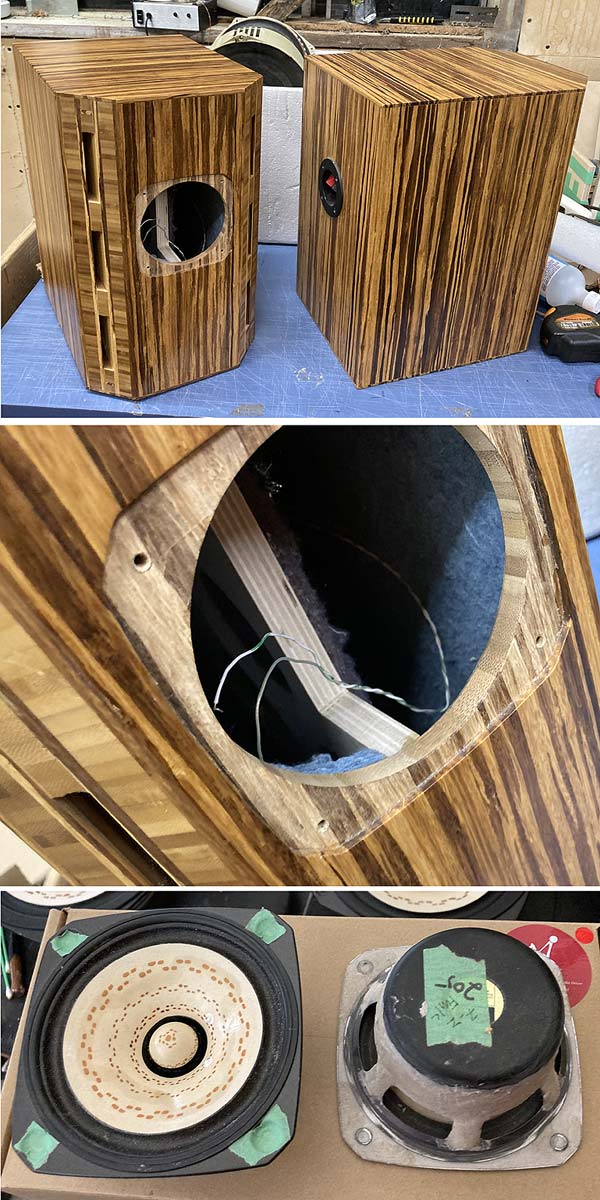
dave
The hard part is finding, or making, 1/4” thick veneer.
These have ¼” yew veneer… made by Bernie.
It should be noted that after the veneer, we had to add some more braces, as the midTL was ringing enuff to really screw things up.
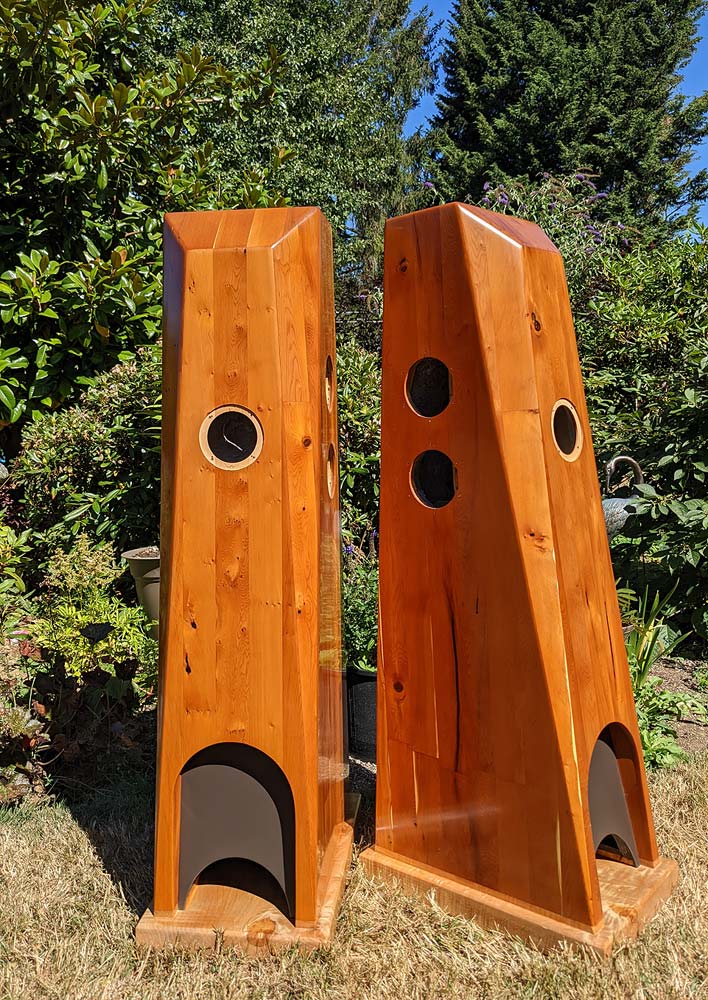
MDF is for making bases or vent spacers.
dave
Hi,
As stated previously, wood changes it's dimensions considerably due to seasonal moisture variations in air. Depending on conditions moisture content in wood can change between 10-20% or so indoors, producing significant movements across direction perpendicular to capilaries. Lengthwise it's more or less stable.
Now, about other stuff - more or less anything wood based. MDF, particle board, HDF, plywood, OSB all are suitable with different finish considerations.
From experience I do not think that any specially high grade ply is necessary but others may disagree.
Regards
As stated previously, wood changes it's dimensions considerably due to seasonal moisture variations in air. Depending on conditions moisture content in wood can change between 10-20% or so indoors, producing significant movements across direction perpendicular to capilaries. Lengthwise it's more or less stable.
Now, about other stuff - more or less anything wood based. MDF, particle board, HDF, plywood, OSB all are suitable with different finish considerations.
From experience I do not think that any specially high grade ply is necessary but others may disagree.
Regards
Agree with the others that say (in my words of course) make the longest dimension of any panel, with the grain.
The other thing, components that don't have to be made of solid wood shouldn't be.
Give your box a fighting chance. Use old wood and seal the heck out of it, both sides. Simple rabbet joints are fine.
Again I am simply iterating the good folks here who know their stuff.
The other thing, components that don't have to be made of solid wood shouldn't be.
Give your box a fighting chance. Use old wood and seal the heck out of it, both sides. Simple rabbet joints are fine.
Again I am simply iterating the good folks here who know their stuff.
Plywood, for the uninitiated, is built by alternating the grain direction on each subsequent layer (ply). As has been pointed out, wood movement is lowest along the grain, higher across the grain. The alternating plies provide stability.
Equal thickness, quality hardwood plies without voids produce a superior product. Compare a nice sheet of 3/4" Baltic Birch to common 3/4" material you'll find at the local big box store. You'll find a variety of constructions, many with a number of thicker softwood plies or even mdf as filler. You'll also probably see a number of small voids. It keeps the price down and is perfectly suitable for many applications. I don't believe that it proves less stiff to any real degree. Stiffness is largely determined by the thickness and integrity of the outer skins. Think I-beams, engineered joist or composite foam core construction.
If an exposed edge is required on your project, edge banding can be used. No amount of filling and sanding makes a presentable edge with these panels imo.
Marine grade plywood comes in a variety of face veneers, is void free and uses waterproof/heat resistant glue (Ive been told that practically all ply uses WP glue these days). Meranti, aka Phillipine mahogany isnt a true mahogany but is likely the most common surface veneer in marine rated panels. Other options are available but can be ridiculously priced.
Grades AA, AB, AC refer to the quality of the face veneers but say nothing about the panel make up.
Some cheap Baltic birch panels mat have a number of voids. The BB at home depot is not the same product thar I buy at Edensaw. I do use it from time to time though.
I've always wanted to try Richlite panels but they're beyond my budget.
Equal thickness, quality hardwood plies without voids produce a superior product. Compare a nice sheet of 3/4" Baltic Birch to common 3/4" material you'll find at the local big box store. You'll find a variety of constructions, many with a number of thicker softwood plies or even mdf as filler. You'll also probably see a number of small voids. It keeps the price down and is perfectly suitable for many applications. I don't believe that it proves less stiff to any real degree. Stiffness is largely determined by the thickness and integrity of the outer skins. Think I-beams, engineered joist or composite foam core construction.
If an exposed edge is required on your project, edge banding can be used. No amount of filling and sanding makes a presentable edge with these panels imo.
Marine grade plywood comes in a variety of face veneers, is void free and uses waterproof/heat resistant glue (Ive been told that practically all ply uses WP glue these days). Meranti, aka Phillipine mahogany isnt a true mahogany but is likely the most common surface veneer in marine rated panels. Other options are available but can be ridiculously priced.
Grades AA, AB, AC refer to the quality of the face veneers but say nothing about the panel make up.
Some cheap Baltic birch panels mat have a number of voids. The BB at home depot is not the same product thar I buy at Edensaw. I do use it from time to time though.
I've always wanted to try Richlite panels but they're beyond my budget.
Stranded (fossilized) bamboo ply was the best sheet material we used for loudspeakers.
Expensive but no need for veneer.
The only bamboo plywood I can access here in Hong Kong looks like the attached pictures. Are they suitable?
Last edited by a moderator:
Spruce doesn't have the size I needHi,
As stated previously, wood changes it's dimensions considerably due to seasonal moisture variations in air. Depending on conditions moisture content in wood can change between 10-20% or so indoors, producing significant movements across direction perpendicular to capilaries. Lengthwise it's more or less stable.
Now, about other stuff - more or less anything wood based. MDF, particle board, HDF, plywood, OSB all are suitable with different finish considerations.
From experience I do not think that any specially high grade ply is necessary but others may disagree.
Regards
Here are the bamboo board from the supplier, and they claimed that those are not bamboo plywood but bamboo annexation.
Can I have it for speaker cabinet?
Can I have it for speaker cabinet?
Attachments
-
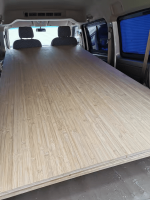 37adfd0bf2fd6f9bc3fe61e24de3f67c (1).png146.6 KB · Views: 80
37adfd0bf2fd6f9bc3fe61e24de3f67c (1).png146.6 KB · Views: 80 -
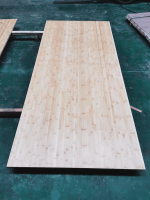 4c8dc65e797fbe5a461e51c103520ac4.png165.7 KB · Views: 76
4c8dc65e797fbe5a461e51c103520ac4.png165.7 KB · Views: 76 -
 640be18bac245e94cc3412a3e77beb10.png169.6 KB · Views: 77
640be18bac245e94cc3412a3e77beb10.png169.6 KB · Views: 77 -
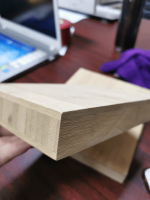 8ed7dad9197a59672bcc427bd3ca28c7.png101.9 KB · Views: 73
8ed7dad9197a59672bcc427bd3ca28c7.png101.9 KB · Views: 73 -
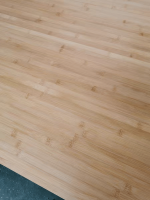 2a53d71156ea80d8c415c641f30c40d4.png155.3 KB · Views: 72
2a53d71156ea80d8c415c641f30c40d4.png155.3 KB · Views: 72 -
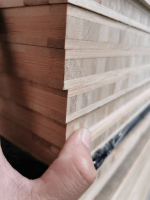 0f55f2f14c24c5131c1caa5551d3ab4f.png141.2 KB · Views: 74
0f55f2f14c24c5131c1caa5551d3ab4f.png141.2 KB · Views: 74
That is called Vertical and is fine. The stuff Dave shows as he mentioned is known as Strand and is the best and hardest but most expensive, hard on your blade and not always available.
Last edited:
Is that better than MDF?That is called Vertical and is fine. The stuff Dave shows as he mentioned is known as Strand and is the best and hardest but most expensive, hard on your blade and not always available.
What Cal said.
Bamboo ply ois made in China, it would be surprising that it couldnot be found. But then Finish BB seems to be hard to get in Sweden.
Bamboo ply is made of a block core with a “veneer” sheet sandwiching it.
Horizontal, Vertical, & Stranded are different constructions of the “veneer”.
The first 2 refer to the orientaion of the grain. Stranded takes bamboo strands and embeds them in some sort of epoxy/binder to create a very stiff sheet. Vertical is suitable for loudspeakers, stranded is better (by more tham a bit).
Both a pretty. Vetical can be dinged, stranded takes a much harder blow to ding. It is also heavier (not a direct asset, it is a consequence of getting the stiffness).
Our first Bamboo cabinet was a free left over bit, just over a half sheet. Enuff to do these except for the backs. The fancy bits are just clever joinery exposing the inner core of the ply to the outside.
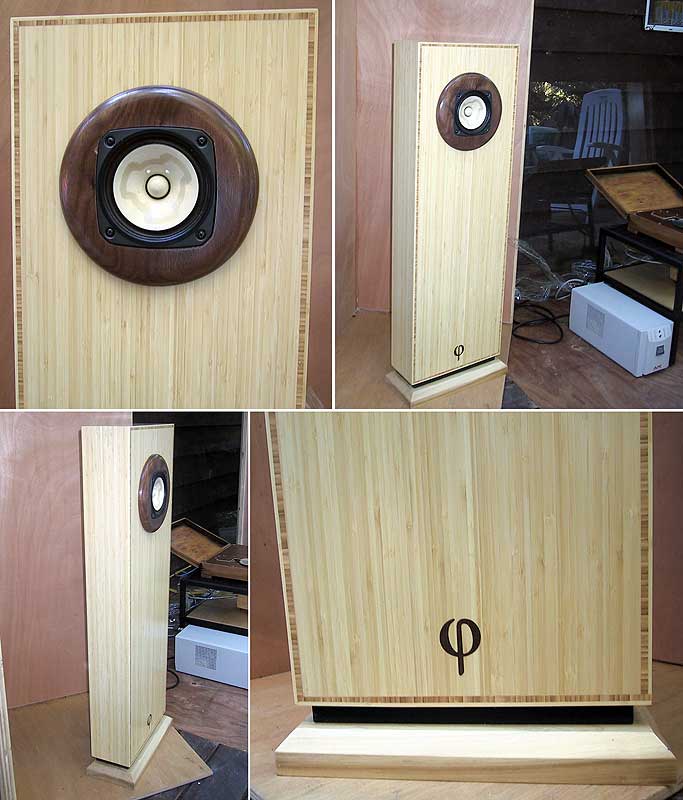
dave
Bamboo ply ois made in China, it would be surprising that it couldnot be found. But then Finish BB seems to be hard to get in Sweden.
Bamboo ply is made of a block core with a “veneer” sheet sandwiching it.
Horizontal, Vertical, & Stranded are different constructions of the “veneer”.
The first 2 refer to the orientaion of the grain. Stranded takes bamboo strands and embeds them in some sort of epoxy/binder to create a very stiff sheet. Vertical is suitable for loudspeakers, stranded is better (by more tham a bit).
Both a pretty. Vetical can be dinged, stranded takes a much harder blow to ding. It is also heavier (not a direct asset, it is a consequence of getting the stiffness).
Our first Bamboo cabinet was a free left over bit, just over a half sheet. Enuff to do these except for the backs. The fancy bits are just clever joinery exposing the inner core of the ply to the outside.

dave
Is that better than MDF?
Even Horizontal is better then MDF. And note that both builds shown are raw plywood with a clear coat.
dave
Almost correct. It refers to the core. Horizontal is flat stacked, vertical is what you show in post 36 and stranded is how you described.Horizontal, Vertical, & Stranded are different constructions of the “veneer”.
Horizontal is flat stacked, vertical
More or less what i said.
dave
- Home
- Loudspeakers
- Multi-Way
- Spruce wood for cabinet??